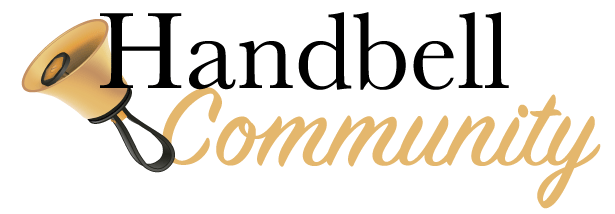 Sponsored by Jeffers Handbell Supply, Inc..
Sponsored by Jeffers Handbell Supply, Inc.. Sponsored by Jeffers Handbell Supply, Inc..
Sponsored by Jeffers Handbell Supply, Inc..It all began that evening. I was standing around with others in small groups, eating cake. We were at a reception following a day of ringing at our Area festival. The room was subdued. Then I heard it - the sound of bells in the distance. Into the room came a high school group dressed in long white flowing robes, playing chimes. Leading the processional which wove amongst us was a young woman playing a bell tree. I thought I had died and gone to heaven.
Sometime later, with Christmas Eve approaching, I realized I had a dilemma. With no bell choir playing, and the 4-in-hand duet partner unable to play the descant to Silent Night with me, it seemed as if there would be no bells during the candle-lighting ceremony. How could there be no bells when the lights went down and the candles were lit? Aha! I remembered the bell tree.
I found a mic stand in the back closet. In the clip at the top, I placed a dowel stick, long enough to balance two bell tree strings on each side. It was pretty rickety, but we had bells with Silent Night!
After the service, a man from my congregation came up to me, and, looking at the stand, said, “Can I help you with that?” Turns out he had designed equipment for the military. He came back with a top to attach to the mic stand. It had a cross bar made on a lathe. With the weight of bell tree strings solved, it opened up all kinds of creative room for bell tree ideas. From that time on, the church Music Director and I schemed. We added bell trees to vocal choir pieces. Introits. Bell choir offerings. The pastor (also my husband) said he didn’t care what we did as long as we didn’t slow the service down. We had a ball!
My husband then retired, and I thought I’d never play handbells again. Much to my amazement, my congregation gave me a set of bells! It was as if they were saying, “Go girl go!” and to continue what I was doing with bell trees. No one else used the bell tree stand, so they said I could take that, too.
I found myself in a new community that had no bell choir. I thought, “Why can’t the bell tree be a solo instrument like a clarinet, or a flute?” I began to experiment with the idea of the bell tree playing the melody, with piano as the accompaniment.
After developing a few solos and playing them in my church, I saw an advertisement for the very first national solo and ensemble festival (SEE) in Colorado. I wondered if anyone else would be interested in this, and I knew if I attended the festival and performed a solo, I would find out. I was excited about sharing the concept, but knew that even if no one else got excited about belltree solos, it wouldn't dampen my own enthusiasm. I would continue to play around with it once I returned home.
For some reason, the accompanist couldn’t rehearse with me, so my accompanist was Kevin McChesney. Kevin McChesney!!! After I had played, he came up to me and said, “Have you ever thought of publishing this?” I had my answer!
Some time later, I found myself on the Handbell Musicians of America - Area 10 Board. The Board Chair thought it important that all board members attend the National Seminar once during their term, and funded us to make it possible. I then got a call. Did I want to play my bell tree music there? I had never given a concert before! But the opportunity to spread the idea of the bell tree solo was too good of an offer to pass up. I squeezed all my setups of different solos into one main setup. It ended up being the noon concert in the Crystal Ballroom! I called it a teaching concert, played what I could, and answered questions afterwards.
From there, it’s history. The Area chairs were there, and invitations began to pour in from all over the country to come to their festival, give a concert, and teach others how to do it.
Along the way, I knew that few would create solo bell tree music from “scratch”. I knew I needed to find a way to get this music into the buckets of music that we all pour through when we attend festivals. STEP (Solo To Ensemble Project) gave me my first entrée into the publishing world. Jill Jeffers gave me my entrée into the festival buckets by saying, “We’ll sell your music!” I dove into the world of self-publishing, creating my arrangements in the Sibelius music writing program and sending hard-copies to Jeffers.
I now email a copy of a new arrangement to Jeffers. They print it, distribute it, and publicize it. They also have had a bell tree display when I’ve been a clinician at festivals. I retain copyright and all editorial corrections to my music. As Tom Jeffers said, “You do what you do best, and we’ll do what we do best.”
It has been a wonderful journey seeing others enjoy bell tree ringing as much as I do. I’m thankful to all the people who have helped this journey along the way.
Barbara's bell tree music may be found in the Tree-O Publications catalog, available through Jeffers Handbell Supply, Inc..